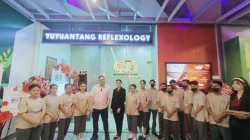A New Era of Broadcasting with Augmented Reality and Virtual Reality
CBS Texas has taken a bold step into the future by launching a groundbreaking augmented reality (AR) and virtual reality (VR) set. This innovation marks the station as the only one in the region to adopt this cutting-edge technology, offering a fresh approach to delivering news and weather coverage. The new AR/VR set was introduced on June 23, creating an immersive experience that brings audiences closer to the stories being told.
To understand more about this transformation, CBS Texas spoke with Adam Bull, the director of broadcast operations and engineering. His insights reveal how this technology is reshaping the way content is created and presented.
Support kami, ada hadiah spesial untuk anda.
Klik di sini: https://indonesiacrowd.com/support-bonus/
How the Technology Works
According to Bull, the technology functions like being inside a video game. The process involves placing a person in front of a green screen, where they are digitally separated from the background and inserted into a virtual environment. This allows them to interact with objects that exist only in the digital space.
The individuals working with the system wear infrared trackers, enabling them to move around and interact with virtual objects. They also use monitors positioned above and in front of them to visualize their surroundings. It takes time and practice to make these interactions look natural, as the participants must adapt to a world that isn’t physically present.
Meteorologists, for example, use an iPad to control the system. They can issue commands such as bringing up a virtual monitor or changing the map on the floor, enhancing their ability to communicate complex information in an engaging way.
Support us — there's a special gift for you.
Click here: https://indonesiacrowd.com/support-bonus/
The Effort Behind the Launch
Bull emphasized that the development of this AR/VR set required significant effort and planning. The IT team spent over six months on construction, rehearsals, and preparation before the system was fully operational. He noted that the technology was initially developed by the CBS San Francisco station, which took several years to perfect.
This level of dedication highlights the complexity involved in integrating AR and VR into traditional broadcasting. It’s not just about the technology itself but also about ensuring that it works seamlessly within the existing workflow of the station.
Looking Ahead
Bull expressed excitement about the future possibilities this technology offers. He believes that the creative teams across news, weather, and sports will find innovative ways to use the AR/VR set. The goal is to create an immersive environment where storytellers can bring their visions to life and take viewers on a virtual journey.
The flexibility of the system is one of its most appealing features. Unlike traditional sets, which are fixed in design, this AR/VR setup can be transformed with the click of a mouse. A single green screen can become a sports arena, a historical landmark, or any other setting imaginable. This adaptability opens up endless opportunities for storytelling and audience engagement.
What Makes This Set Unique?
What truly sets this AR/VR set apart is its versatility. The same set can be used for multiple purposes, allowing for quick and seamless transitions between different segments. This means that the production team can experiment with various visual elements without the need for physical set changes.
As the technology continues to evolve, the potential for creativity is limitless. The future of broadcasting may well be defined by the ability to create dynamic, interactive experiences that captivate and inform audiences in new and exciting ways.







